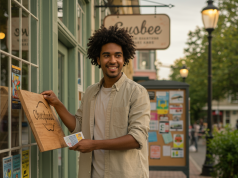In today’s rapidly evolving marketing landscape, the divide between traditional and digital strategies is narrowing. Businesses no longer need to choose one over the other. By combining time-tested offline methods with innovative online tactics, brands can extend their reach, build trust, and enhance engagement. This hybrid marketing model leverages the strengths of each channel—print, events, radio, outdoor advertising, social media, email, and programmatic ads—to create a unified campaign that resonates with diverse audiences. In this comprehensive guide, we will explore why a hybrid approach matters, how to plan and execute it, and best practices for measuring success.
The Case for a Hybrid Marketing Strategy

A purely digital campaign may deliver quick metrics, but offline channels often build deeper emotional connections. Conversely, traditional media can be costly and less targeted without digital support. A hybrid strategy combines the broad awareness of print or outdoor ads with the precise targeting and interactivity of online platforms. This synergy can lead to higher brand recall, greater customer loyalty, and improved conversion rates. According to recent studies, campaigns that integrate at least three offline and two online channels see up to a 35% increase in overall engagement. The hybrid model also allows marketers to diversify their budget and reduce dependency on any single channel, making campaigns more resilient to market fluctuations.
Key Channel Pairings for Maximum Impact
1. Print Advertising and Social Media Campaigns
Print ads in newspapers, magazines, or direct mail flyers remain trusted sources of information. To bridge offline and online, include QR codes or custom URLs that lead readers to dedicated landing pages or social profiles. A well-placed print ad can drive interested prospects to follow your brand on Instagram, Facebook, or LinkedIn. Once there, you can retarget them with sponsored posts or dynamic ads that reinforce the same messaging and visuals used in print, creating a seamless journey from brochure to browser.
2. Direct Mail and Email Marketing
Direct mail and email marketing share many parallels—both deliver personalized content directly to the recipient. Use postcards or brochures featuring unique promo codes that customers can enter on your website or in an email sign-up form. Combining tactile mailers with follow-up email sequences increases open rates by up to 50%, as recipients recognize a coordinated effort and feel more compelled to engage. Ensure your creative design, tone, and call-to-action remain consistent across both formats for maximum recall.
3. Events and Webinars
Trade shows, conferences, and local vendor events allow face-to-face interactions, while webinars and virtual workshops broaden your audience online. Promote your in-person event with targeted email invites, social media ads, and posters in your community. During the event, capture attendee data and invite them to a follow-up webinar or live stream. Conversely, advertise your virtual sessions at physical venues using banners and handouts featuring the webinar URL or QR code. This two-way promotion fosters a continuous learning experience and keeps your brand top of mind across formats.
4. Out-of-Home Advertising and Programmatic Digital Ads
Billboards, transit ads, and posters excel at generating mass awareness, while programmatic digital ads deliver precision targeting and frequency control. Display the same visual motif and tagline on a roadside billboard and across Google Display or social media networks. Use geofencing to retarget mobile devices in proximity to your offline ad locations, reinforcing your message in real time. This technique increases ad recall by up to 50% and drives both foot traffic and online conversions.
Creating a Cohesive Message Across Channels
Consistency is key in a hybrid campaign. From the headline and color palette to the tone of voice and call-to-action, ensure that each channel reflects the same brand identity. Develop a creative brief that outlines core messaging, mood, design assets, and target audience personas. Host regular cross-departmental meetings—between your print, digital, and events teams—to align on timelines, asset handoffs, and monitoring protocols. When consumers encounter your brand offline, they should instantly recognize it online and vice versa.
Allocating Budget for Hybrid Campaigns
Budgeting a hybrid strategy requires balancing the higher production costs of traditional media with the analytics-driven spending of digital. Begin by defining clear objectives for each channel—brand awareness, lead generation, or direct sales. Allocate a percentage of your total budget to foundational offline elements (such as print design or event sponsorship) and the remainder to trackable digital tactics (PPC ads, social promotions, email automation). Reassess monthly based on performance data, shifting funds toward channels delivering the strongest return on ad spend (ROAS). This dynamic reallocation ensures you capture both broad impressions and targeted interactions without overspending on underperforming media.
Technology and Tools to Support Integration

Modern marketing stacks include CRM platforms, marketing automation, and analytics suites that bridge offline and online efforts. Use QR-code generators linked to UTM-tagged URLs to track scan-to-web conversions. Employ marketing automation to trigger email sequences when a customer responds to a direct mail piece. Integrate your CRM with ad platforms to create custom audiences based on purchase history or event attendance. Leverage dashboard tools like Google Data Studio to visualize combined data from offline ad impressions and digital click-throughs, enabling real-time campaign adjustments.
Measuring Hybrid Campaign Success
Traditional metrics—circulation, foot traffic, or impressions—must be paired with digital KPIs like click-through rates, conversion rates, and cost per acquisition. Assign unique promo codes or vanity URLs to each offline touchpoint to track which assets drive the most online engagement. For events, compare badge scans to post-event webinar attendance and subsequent sales pipeline entries. Use A/B testing on digital follow-ups to optimize messaging and timing. By merging datasets in a unified analytics dashboard, marketers can not only measure overall campaign performance but also identify key drivers of digital marketing success, uncovering synergies between offline and online channels.
Best Practices for Integration
- Maintain consistent branding and messaging across all touchpoints.
- Plan campaigns around a central theme or objective.
- Use trackable URLs, promo codes, and QR codes in offline materials.
- Invest in tech that unifies offline and online data streams.
- Regularly review performance metrics and reallocate budget agilely.
- Train teams on cross-channel coordination and workflow processes.
Case Study: Hybrid Campaign in Action
Consider the example of a regional coffee chain that wanted to boost loyalty program sign-ups. They ran full-page ads in local magazines featuring a QR code for a free drink, mailed personalized postcards with a unique promo code, and hosted a weekend pop-up event. Simultaneously, they deployed Facebook and Instagram ads targeting the same postal codes and interests, inviting followers to the pop-up. Within two months, their loyalty database grew by 40%, online orders increased by 25%, and the pop-up saw a 75% redemption rate on printed vouchers. The integrated messaging and seamless customer journey drove measurable results across both offline and online channels.
Conclusion
A hybrid marketing approach is no longer optional—it’s essential for brands seeking to maximize reach, engagement, and ROI. By thoughtfully pairing traditional channels with digital tactics, maintaining consistent messaging, and leveraging technology to track performance, marketers can craft campaigns that resonate on multiple levels. As consumer habits continue to blend offline and online experiences, the brands that master integration will stand out in the crowded marketplace. Start small, measure often, and scale the channels that prove most effective. Your next winning campaign lies at the intersection of tradition and innovation.
Learn more about: Revitalizing Your Brand: Traditional Marketing Strategies for the Digital Age









